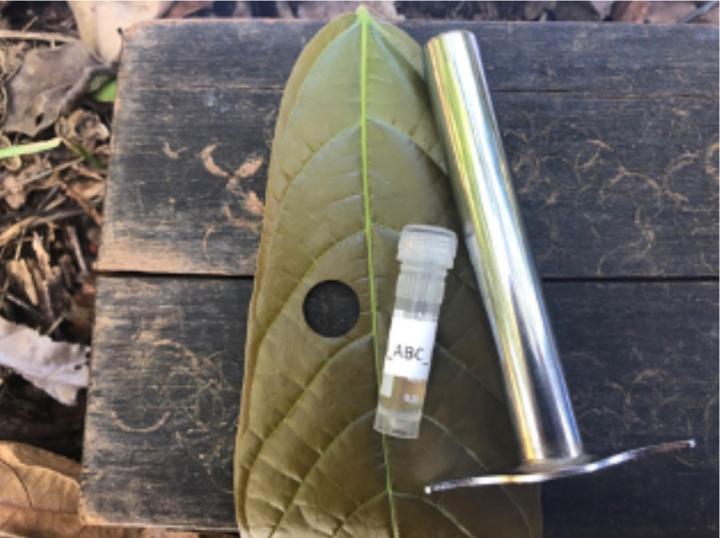Clovamide presence in disease-resistant chocolate tree leaves may spur novel breeding program

Credit: Ben Knollenberg/Penn State
The finding of relatively high levels of the antimicrobial compound clovamide in the leaves of a disease-resistant strain of cacao has significant implications for breeding trees that can tolerate black pod rot, according to Penn State researchers who conducted a novel study.
The discovery is significant because this fungal disease is a serious problem in all areas of the world where cacao is grown, noted researcher Mark Guiltinan, J. Franklin Styer Professor of Horticultural Botany and professor of plant molecular biology, College of Agricultural Sciences. Black pod rot, caused by the fungus Phytophthora, causes pod losses of up to 30% and kills as many as 10% of the trees annually.
“This is the first time that clovamide has been implicated in cacao resistance to pathogens, and the innovative method we used to measure the compound in the leaves could have a major impact in the quest to develop highly productive, disease-resistant varieties of cacao,” Guiltinan said. “But these results may have consequences for advancing disease resistance in other plant species, as well.”
In the study, leaves of a cacao variety known as “Scavina 6,” which is tolerant of the fungus that causes black pod rot, were found to accumulate dramatically higher levels of clovamide and several other metabolites known to be involved in responses to stress — compared to a susceptible cacao strain, “Imperial College Selection 1.” Clovamide was the most abundant compound in Scavina 6 leaf extracts, with concentrations up to 58-fold higher than in Imperial College Selection 1.
Researchers discovered this dramatic difference in clovamide accumulation by comparing the abundance of hundreds of specialized metabolites in the two cacao strains using liquid chromatography and tandem mass spectrometry at Penn State’s Metabolomics Facility, part of the Huck Institutes of the Life Sciences.
“These results pointed to clovamide as a potential contributor to disease resistance, and laboratory tests supported this hunch,” Guiltinan said.
Laboratory assays demonstrated that the compound inhibits the growth of three pathogens of cacao in the Phytophthora genus. Also, in another experiment, clovamide inhibited the activity of the enzymes proteinase and pectinase, which are known to break down plant cell walls. Based on this evidence, it is likely that clovamide prevents pathogens’ ability to break down cell walls while killing and digesting plant tissue, the researchers said.
The study’s findings, published today (Dec. ??) in Frontiers in Plant Science, promise to enhance plant-breeding efforts to develop highly productive varieties of cacao that can withstand the onset of black pod rot, lead researcher Ben Knollenberg suggested. A postdoctoral scholar in plant science at Penn State, he said the method researchers used to measure clovamide levels in leaves could greatly streamline and condense the breeding process.
“The Scavina 6 strain has been utilized as a parent in cacao-breeding programs for decades, but it hasn’t been clear why it’s resistant to black pod rot, which makes breeding for resistance difficult,” he said. “Breeders cross Scavina 6 with higher-yielding varieties, for example, and they get a bunch of seeds or offspring, which may or may not have inherited the disease resistance. Evaluating the disease resistance of this new generation of trees requires years of growth and measurements in field trials, which requires land, labor and money.”
If breeders can screen for leaf clovamide content when the trees are just seedlings in the greenhouse, they can eliminate trees that lack the trait before transplanting the seedlings to the field, Knollenberg pointed out. This will increase the chances of obtaining disease-resistant varieties and will reduce the resources required for cacao breeding.
“This is essentially ‘marker-assisted selection,’ which typically employs markers based on DNA sequences, but in this case, it involves a chemical trait or a ‘metabolic marker,'” he said.
The researchers hope that using clovamide as a resistance marker becomes a useful tool in cacao breeding programs, which would be especially welcome because much of the cacao tree crossing is done in countries that don’t have well-funded breeding programs.
“We think this will accelerate breeding and make it more efficient so that breeders can develop resistant varieties more quickly,” Knollenberg said. “For example, instead of growing 1,000 trees to evaluate resistance, with the ability to measure the relative abundance of clovamide in the leaf tissues, they could grow just the 100 highest-clovamide trees instead.”
###
Also involved in the research were Guo-Xing Li, postdoctoral researcher in the Department of Chemistry, Joshua Lambert, professor of food science, and Siela Maximova, research professor of plant biotechnology.
Penn State’s College of Agricultural Sciences, the Huck Institutes of the Life Sciences, the Penn State Endowed Program in the Molecular Biology of Cacao, the J. Franklin Styer Professor of Horticultural Botany Endowment and the U.S. Department of Agriculture’s National Institute of Food and Agriculture supported this project.
Media Contact
A’ndrea Elyse Messer
[email protected]
Related Journal Article
http://dx.




